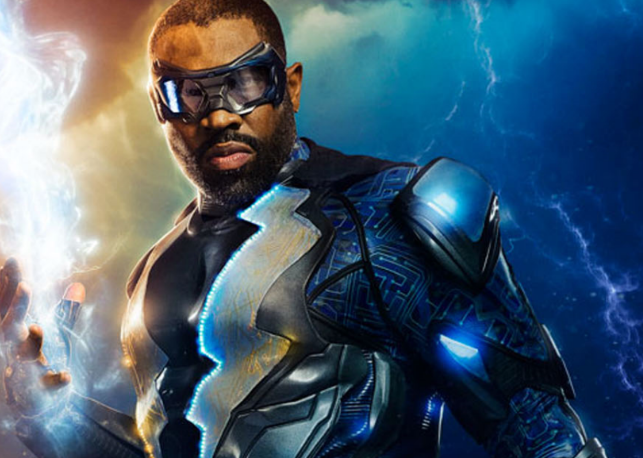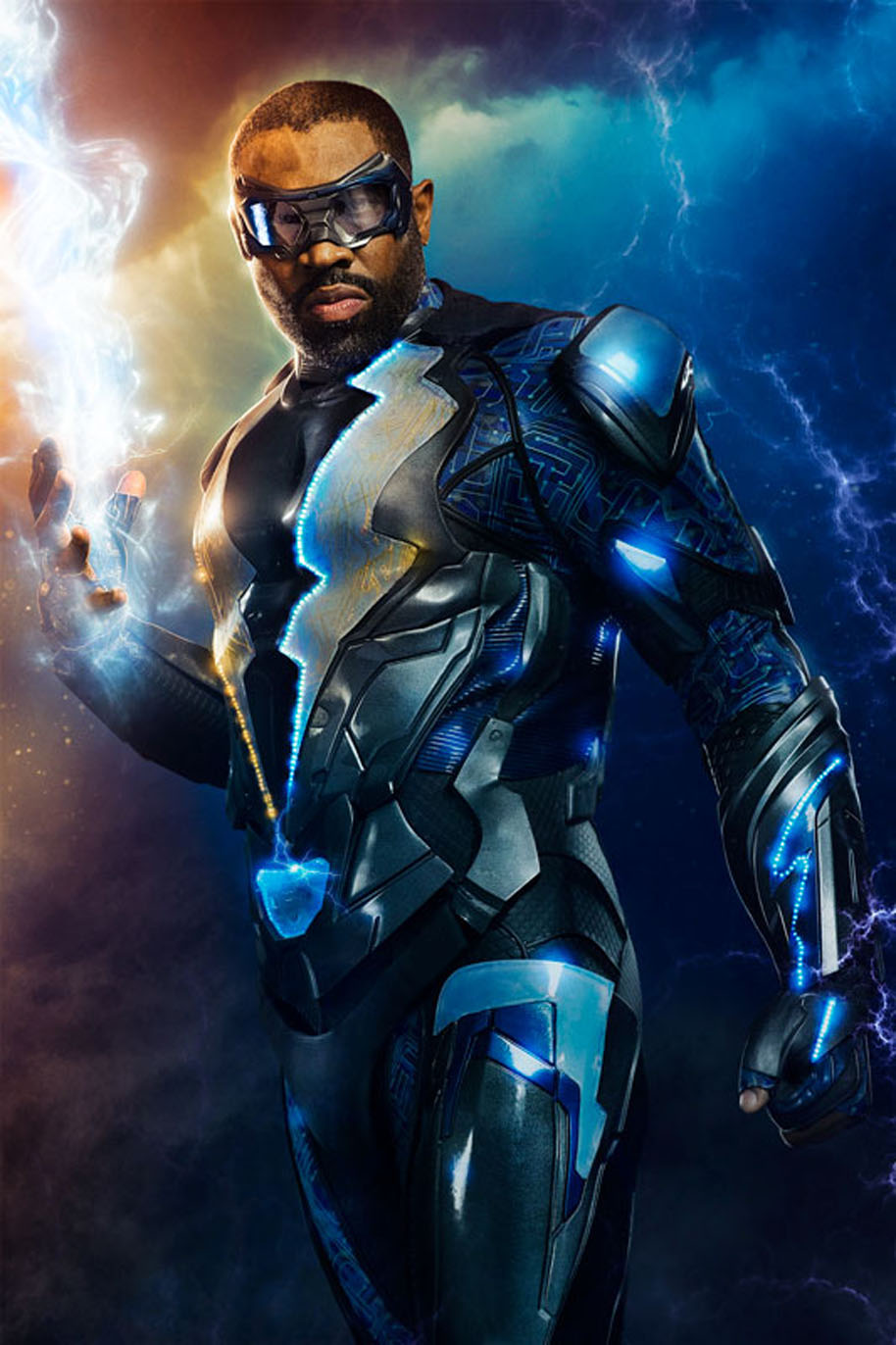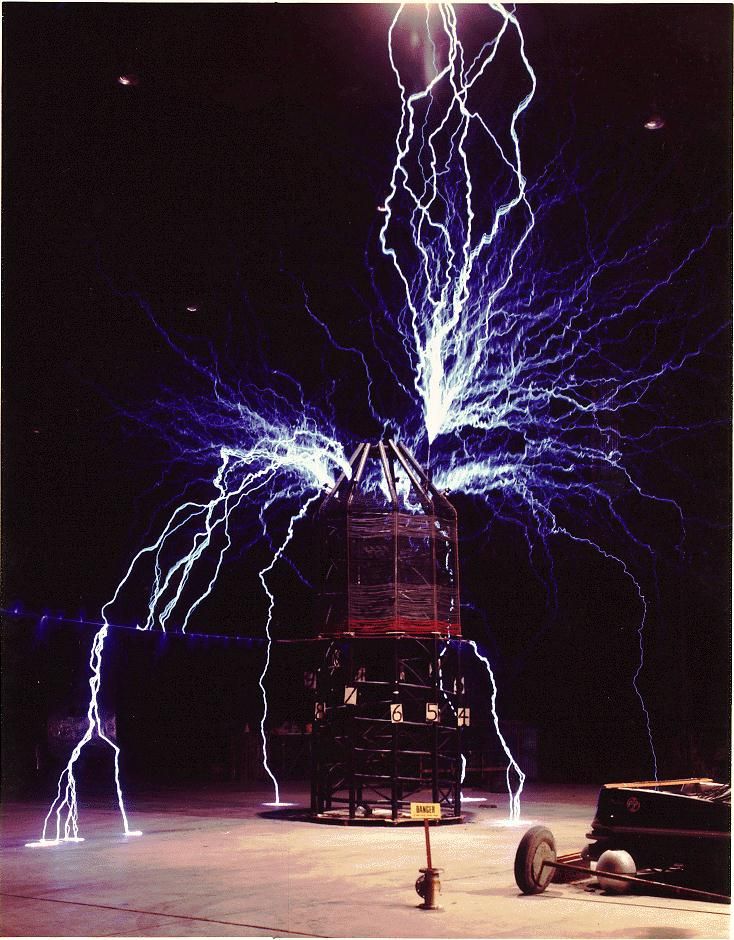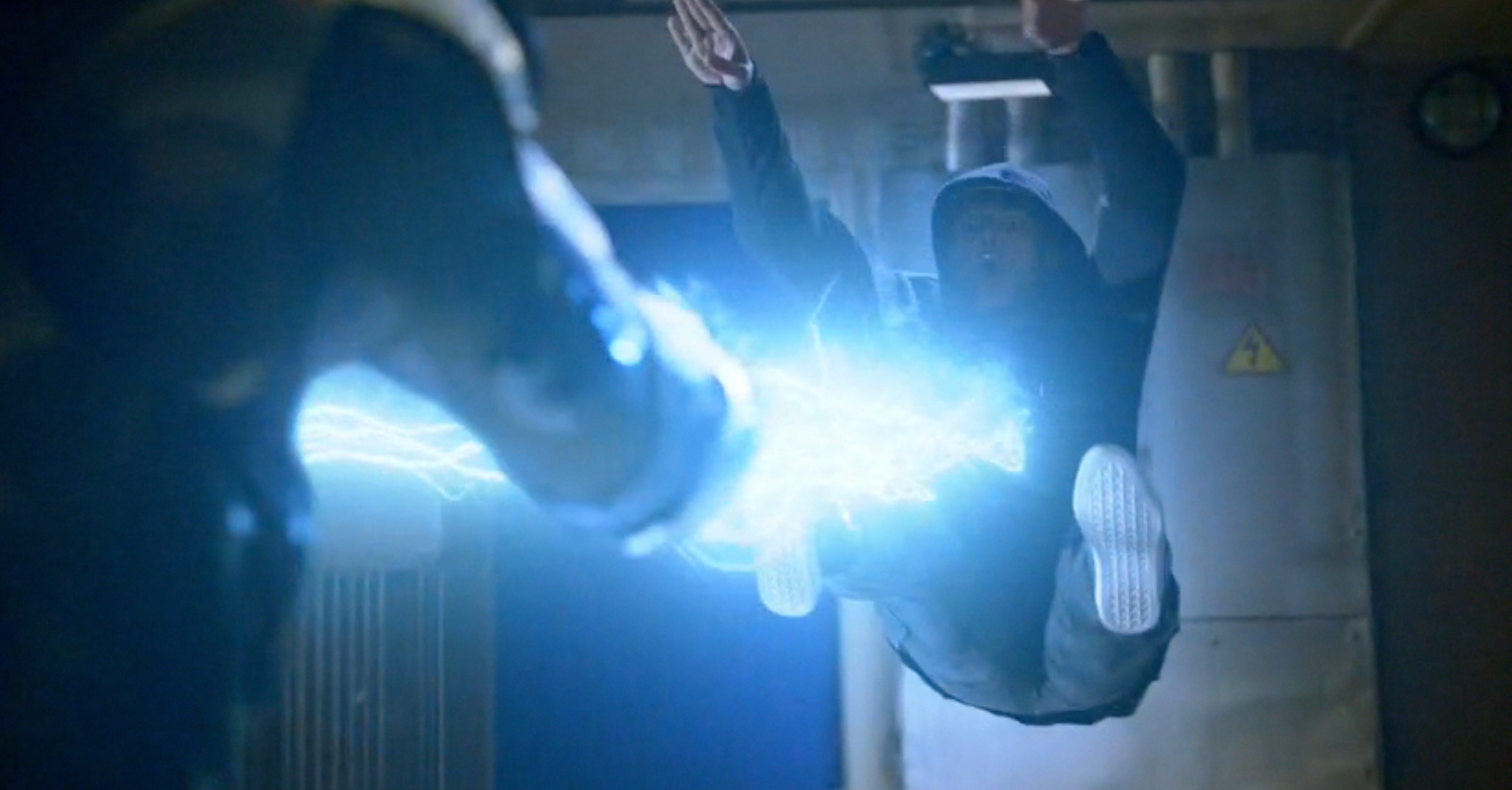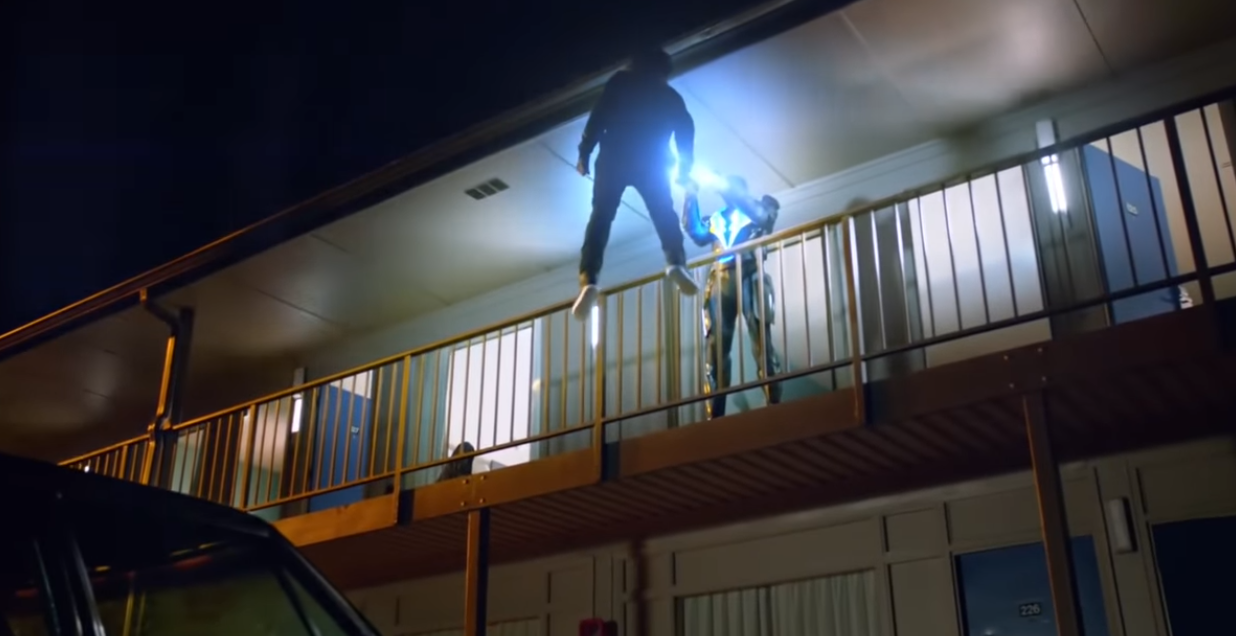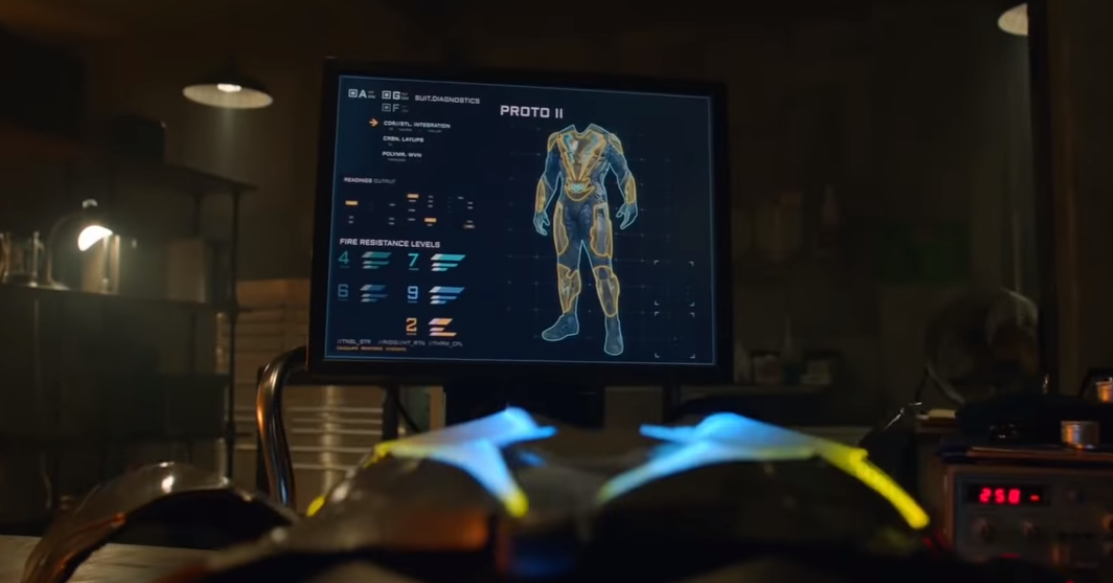Memo to Black Lightning – lightning as your superpower is troublesome – but only if you’re in our world.
Black Lightning debuted on The CW recently to solid reviews from critics and fans, which is awesome. If you missed it, the first episode is available to purchase through your vendor of choice, or is still streaming on The CW’s website here. Tonally and culturally, the show, headed up by Salim Akil, stands out as something unique when compared to other shows based on DC characters and superhero shows on TV in general.
ICYMI, or are unfamiliar with the character, Black Lightning centers on Jefferson Pierce, a former Olympian and now high school principal in the community of Freeland. Pierce also was Black Lightning, a “vigilante” (or hero, depending on who you ask) that operated in the city. Black Lightning’s target was one Tobias Whale, the leader of The 100 Gang. Nearly a decade ago, Pierce gave up the costume and crime fighting to focus on his family and what good he could do in the community as an educator and principal, rather than a superhero. Events in the first episode force his hand, and he finds that to save his family, he has to put the costume on once again.
Black Lightning’s powers, if the name hasn’t given it away, are electricity based and to date, mostly consist of…lightning bolts fired from his hands. His new suit seems to channel the lightning or store it like a capacitor, perhaps allowing him to multiply his initial voltage into something much larger. So far, we’ve seen Black Lightning use his electrical blasts mostly as force bolts (pushing people away), and to hold on to people. Neither looks to be too comfortable to the pushee or the person he’s holding on to.

Telling any child about midichlorians is now considered child abuse in many galaxies, including ours. (c) Disney/Lucasfilm
Avoiding The Midichlorian Problem
But let’s interject a quick moment for reality: this isn’t lightning, or electricity as we know it – for a variety of reasons that we’ll explain, and we’re okay with that. Over at io9, actor Cress Williams acknowledges this saying, “When he’s using his electricity, just because it touches someone doesn’t mean it’s necessarily shocking them. He actively makes that choice whether the electricity’s going to be strong or soft.”
And that’s fine – actually, it plays well with DC’s history of electricity that’s “not really” electricity, like the lightning bolt that turns Billy Batson into Captain Marvel, or the magical lightning bolt of the Justice Society’s Johnny Thunder.
We hope that the series continues to play fast and loose with Black Lightning’s electricity – without going totally crazy. Trying to use science to explain Black Lightning’s powers are like trying to explain how much food the Flash must eat to run as fast as he does, or any other number of bizarre hand-wavy explanations creators put in to explain the “science” of the story they’re telling.
In other words, we hope DC doesn’t create its own Midichlorian Problem when it doesn’t have to. Don’t try to tie what is essentially “magic” into our understanding of science. If they do, as thousands of fist-shaking Star Wars fans can confirm, they’ll only create more problems. Now, your made-up science now needs more science to explain it. And worse yet, you’ve inadvertently invited in nerds like us to start asking more questions about the science you just made up, and that only ends in passive-aggressive answers to fan questions at Comic Con panels. So, no CW/DC please don’t make Black Lightning like an electric eel. Don’s measure or quantify anything about him. Don’t have him check in with his version of STAR Labs to try and understand his powers better. Just…don’t.
When it comes to science and Black Lightning, keep a light touch.
But – that said, we can still use Black Lightning to look at some real science of lightning and consider what blending in some real science would look like, because after all – that’s what we do around here.
Moving Electricity Through Air
Three major points to remember about electricity:
- Electricity is just flowing electrons.
- Electricity is lazy.
- If you slow electricity down, you create heat.
When moving, electricity likes to take the path of least resistance, which means it will choose a conductor over an insulator any time. For our discussion, a conductor is something, like metal, whose atoms have electrons that are loosely held, allowing them to move, and let an electrical current flow through them. Insulators – not so much.
If you put air into one of those two categories, it’s on the insulator side of things rather than conductor. That’s why you don’t see electricity arcing between the plugs of a wall outlet in your house. You can make electricity flow through air if you have a strong enough push, though – think of lightning. That “push” is called voltage.
Okay, calling voltage the force behind a “push” of electrons isn’t 100% accurate. Voltage also goes by the name electromotive force or potential difference, and what it boils down to is the difference in electric potential between two points. Think if it as the difference in electrical charge between the two points. The more volts something has, the more pressure it pushes with to get those electrons moving to another place, whether it’s somewhere down a wire in a circuit, or, in Black Lightning’s case, through the air. If you need more, check out SparkFun Electronics’ terrific explanations and videos here.
Now – think back to getting electricity to move through air. Air isn’t a great conductor, so that means if you want electricity to travel through it, you’ve got to give it a very strong push, or, the difference between the charges of the two objects needs to be massive. How massive? It’s the type of massive of “When you have enough voltage on your side, everything is a conductor” massive.
How much voltage do you need to push electricity through air? Now you’re talking about the dielectric strength of air, which is the maximum amount of electricity a material can handle without breaking down. If you’re getting less electricity than the dielectric strength, you’re still an insulator. If you’re getting more, well…you’re not exactly a conductor, but the electrons are moving through you. Dielectric strength is measured in Volts/meter, or more often, megavolts/meter (mega = million).
The dielectric strength of air depends upon many factors, such as humidity, temperature and density, but a typical rough approximation is 3 MV/m or 3 million volts per meter (2 million AA batteries’ worth). For comparison, voltages in high power transmission lines top out at around 765,000 volts. This is what it looks like when the dielectric strength of the air is surpassed in our world:
Let’s give it up for lightning – real lightning for a minute.
Regular lightning bolts travel from the bottom of clouds to the ground, roughly 910 meters. Their voltage varies on any number of things including the diameter of the bolt and air conditions, but due to all the charged particles in the air during a storm, the overall resistance of the air drops dramatically, allowing bolts to be produced well below the threshold of 3 million volts/meter, or 3000 volts/millimeter. Watch them in slow motion, and you’ll see the leads of the lightning bolt “probe” the air for channels that have less resistance, ultimately resulting in the larger bolt that reaches the ground.
That said though, typical lightning bolts have a voltage of several hundred thousand to a million volts or more.
It’s the Amps…
Old electricians have a saying…
Well first, there’s this other saying: “There’re old electricians, there are dumb electricians, but there aren’t many old, dumb electricians.”
And those old electricians have a saying: “It’s not the voltage that gets you. It’s the amps.” Or the British version, “Volts jolt, current kills.”
If voltage is the push, amps measure the actual things (electrons) that are being pushed per second. And it’s a lot. One ampere is roughly equal to 6.2415093×10^18 electrons moving past a point in one second.
Amps measure current. You can survive a high voltage/low current situation. How do you know this? The next time you get a static shock, measure the distance between your finger and the object that the spark jumped to. Now, use the 3 million volts/meter (or 3000 volts/millimeter) factor, and ballpark out the voltage needed for that spark to jump. Even if the distance is just a half a centimeter, that voltage is not a small number.
High current though – that’s a completely different story.
While the wiring in your home may be rated to 15 or 20 amps, humans worry about amps in the milliamp range (1 mA = 1/1000 A). 1 mA is barely perceptible, and if you get hit with 16 mA, you’ll feel it and you can still let go of the object – at currents above that, you’re muscles contract and you can’t “let go.” Your respiratory muscles are paralyzed by 20 mA, and 100 mA will disable or destroy the sinoatrial node in the heart, causing the heart to go into unsynchronized contractions (fibrillation) or stop beating altogether.
Humans are really responsive to current because that’s what runs us. Small currents cause our muscles to contract, our thoughts to happen, our cells to communicate with each other, and literally hundreds of other bodily functions to happen. Without current, they don’t happen. Too much current, bad stuff happens.
All that said though – in regards to the respiratory muscles and heart – the electricity must get inside you, and luckily, your skin has a high resistance. Higher the resistance, the less current can get through. That’s why you’re still alive despite that time you stuck a fork into the 120V socket in your house. Don’t try it again, though.
Okay – back to lightning, then? Lightning can carry upwards of 20,000 amps.
Remember Laziness?
Okay – voltage pushes the current, and then what?
Electricity says, “Man, why you botherin’ me? I just want to rest.”
Basically.
In short, the current in lightning just wants to get to the ground. If we’re talking lightning, it doesn’t matter if you’re in the way, or a tree is in the way. It’s going to reach the ground. Having the electricity flow from source through thing where it’s being used (you, unfortunately) and then to the next path (ground) makes a circuit.
The electricity can travel through you or “over” you thanks to the skin effect which allows high frequency current to concentrate on the outermost surfaces of the conductor. If that electricity travels through you, though…
High Voltage + High Current = Not a Good Time
Before you start planning to chase down a thunderstorm to get hit by lightning, we’ve got a few more things to mention.
First – at voltages over 500V, the high resistance of skin, and thus the skin breaks down, which results in a decrease in resistance, so more current can move through – and into – you. That’s worse than the current going over you in every way possible, mostly because we’re just talking bags of salt water with anxiety. Salt water conducts electricity really, really well.
Also – the air around lightning is hot. Really hot. Like 36,000°F hot, which is about three times hotter than the sun, which pushes the air into the next state of matter up, plasma.
That heat, in and around the lightning, is enough to turn any water into vapor, causing an explosion. In a tree, the tree will blow apart. 10,000 amps in your finger disintegrates your finger. Water on your skin – vaporize, possibly with enough force to destroy your clothes. Strong voltages – you’re gonna get burned. And of course, going back to our three important thoughts – your skin’s resistance to electricity is high, which means it’s going to slow the flow of the current down. Slow electricity down, and all of that energy has to go somewhere, and it does – it gets turned into heat. Think of your toaster. Mmmm….toast. Now, think of where in your toaster the resistance is high and the current slows down.
Lightning also carries force with it, and will most likely hit you with enough oomph to cause a blunt force trauma, just from the “punch.”
Getting any serious shock, lightning or otherwise, hurts. This can be due to the heat on the surface in in the tissues of your body that are carrying the current, due to the massive overstimulation of the nerves in the path of the current, or the tetanus (prolonged contraction) of the muscles that are being overstimulated.
Lightning is really loud and really bright. Getting hit by lightning can rupture your eardrums and the light energy can cause cataracts.
Often, getting hit by lightning leaves you with a souvenir: a Lichtenberg Scar. These are often delicate, lightning shaped “tattoos’ created when the electrical current traveled through surface blood vessels, tracing them out with enough heat to harm the surrounding tissue.
On the plus side, lightning strikes are quick – 1-3 milliseconds – and if you’re lucky, can leave your heart still beating. The problem with longer shocks is that they’ll most likely be longer than 1 full heartbeat (a cardiac cycle, say around 800 milliseconds) and screw up the rhythm of the heart, cause it to stop or go into fibrillation.
Oh, and hey – if you want one smarty-pants type of fact to take away from thinking about Black Lightning and real lightning, the difference between an “electric shock” and “electrocution” is death. The word electrocution comes from combining “electro” and “execution,” and as far as words go, is relatively new, first coined in 1889 just prior to the first use of the electric chair in 1890 for an execution.
Back to Black Lightning…And Some Science
Given everything we’re seen about lightning, it Cress Williams’ statement about Black Lightning’s ability to control the lightning’s strength makes perfect internal sense for the series, and keeps real science away. Otherwise, Pierce is most certainly killing people either accidentally or on purpose with his bolts.
Take the hotel assault scene in the first episode, for example. While the bulk of Pierce’s methods were electrically enhanced hand-to-hand combat and grappling(*), and electric punches would really hurt, he was shooting blots at bad guys anywhere from about two to four meters. Use the 3 MV/m approximation: that’s six to eight million volts those bad guys were being hit with.
In our world, that would mean: seizures, blunt force trauma, skin breakdown, current traveling inside the body and most likely, death. A painful, painful death. Even if he made the electricity “soft.” Not to mention, any bolt he fired – unless he had control over it – would’ve gone directly to the nearest metal, not the human target. Again though, this isn’t “our” electricity as we understand it from our world, otherwise, virtually every one of the gang members that got zapped would be dead.
But to be fair – Pierce really doesn’t seem to have any problem with his enemies dying – or getting killed – while they battle him. He did use a gang member as a human shield, after all, and the guy did take three to the chest as a result.
Blending real science in with Black Lightning would give him some solid limitations – although we’re sure some will be revealed as time goes by. Again, going back to the 3 MV/m guideline, his enemies can simply be out of range, as long as we accept the idea that Pierce can only generate a finite amount of electricity(**), and air conditions affect how far the electricity can travel. Want to take on Black Lightning from a distance? Don’t do it on a humid day. Air resistance decreases with increased humidity.
Likewise, Pierce’s electricity + a little science could yield some creative uses:
A gang leaning against a metal rail? Pierce touches it and zzap. They’re all out. Same for metal floors to walls.
Someone he’s holding on to slipping out of his grip – send a small current that way, and the muscles in their hand contract to the point they can’t let go (just like in Iron Man 2).
Maybe Pierce can detect electrical fields as well as generate them. All muscle movement creates a small electrical field, but it’s virtually imperceptible in the air (it travels through water well – which is how some animals with electroreceptors like the platypus, hunt their prey). Pierce sees a room full of bad guys, shuts off the lights, and just by moving, they “light up” for him.
He’s a walking emergency defibrillator – but on the flip side, as mentioned, he’s also a walking cause of heart attacks.
Any time he sends electricity through something, heat is created, so he can heat a room on a cold night, or, like an incandescent light bulb, make enough light to read by.
Oh, and hey – lie detectors work by detecting very small changes in the resistance of the skin caused by the release of micro-drops of sweat when you lie. Again, if Pierce can detect electrical fields as well as generate them, he could be a walking, talking polygraph, able to tell if a person is lying to him by gently holding their hand and asking them questions, as opposed to barely holding back a huge bolt of electricity while yelling, “Don’t lie to me!” at a suspected bad guy. No need Jeff, no need.
And none of this is even touching on what he could do with magnetism. Wrap a wire around a large iron bar, hold on to both ends of the wire, and you’ve got an electromagnet. We’re betting this will come up later this season, as electricity and magnetism are essentially the same thing, just in different forms.
As for his enemies, since the members of The 100 Gang seem to be rather tough (Lala did take a harpoon to the chest and seemed to be okay), so getting zapped by Black Lightning doesn’t seem to cause the third-degree burns that getting hit by lightning causes in our world. But it would be cool if they all had a Lichtenberg Scar from their encounter. It would be a badge of honor of sorts – that you stood against “The Lightning” and lived to tell about it.
Also – since Pierce has Peter Gambi as his father figure and mentor who seems to have figured out how his powers work, and creates his super-suit for him, it only makes sense that in the years Black Lightning was fighting against Tobias Whale and The 100 Gang that they found their own expert as well – or have found one as insurance in the years during which Black Lightning has been missing. Building an opposing super-suit that insulates the wearer wouldn’t be that hard, as their are many materials that have higher dielectric strength than air that could be engineered into wearable armor (looking at you, Plastic Man). Add a capacitor or an amplifier to the armor to store or multiply the electricity, and send it back at Black Lightning at greater strength than he sent it to you.
In short, there are all kinds of ways the show can go with Black Lightning’s powers, some “science-y” in nature, and some more…creative and playing fast and loose with how we understand electricity. We’re biased for the “science-y” but story wins when it comes down to story vs. science.
But we were struck by one thing Pierce said in the episode. Paraphrasing, he explained that, by being a principal at Garfield High, he’s saved far more lives than he ever did as Black Lightning. We can’t argue there. It was a poignant moment of self-realization for Pierce as a character that only shows his return to the streets as Black Lightning isn’t something he wants to do at all, which adds a depth and complexity to his character, and – along with the cool science-ish stuff, will keep us watching for the full season.
(*) – Yeah, some of the uses of electricity were a little…off from how we experience electricity in our universe, and we’ve got no explanation for them, or are all that interested in explaining them. See up top: Midichlorian Problem.
(**) – Don’t care how or where it comes from. Yes, it’s a gross violation of the law of conservation of energy to have Black Lightning shoot bolts of 6 – 9 million + volts out of his body because a 3 million volt bolt represents a ton of Joules of energy, and the only way humans can get said energy is by eating, so we’re back at the Flash’s issue of eating tons of food a day just to run fast. Please, no scenes of Jeff tucking into a huge meal saying, “Gotta eat a lot to make all that electricity!” Just…no.
For more:
Conduction of Electric Current to and Through the Human Body: A Review
Why does lightning push electricity through air, but common batteries do not?


